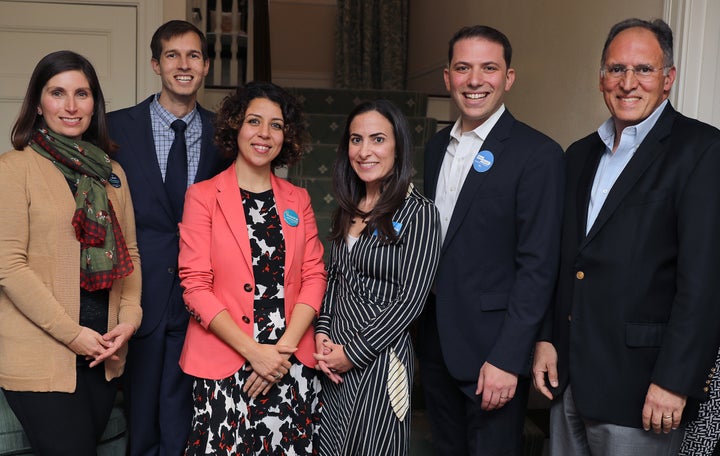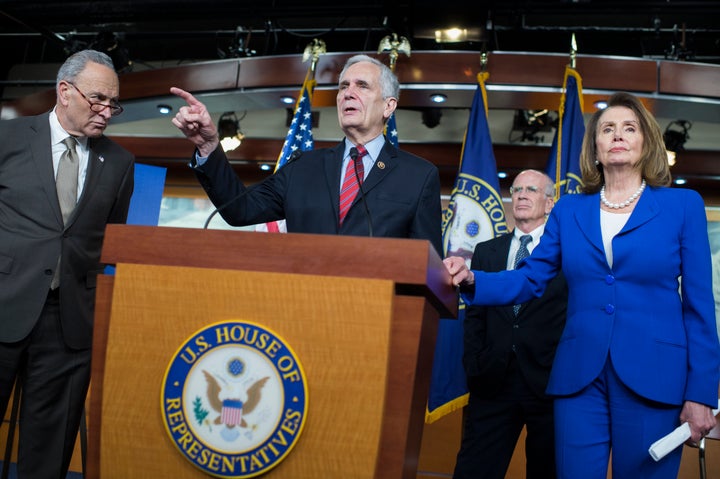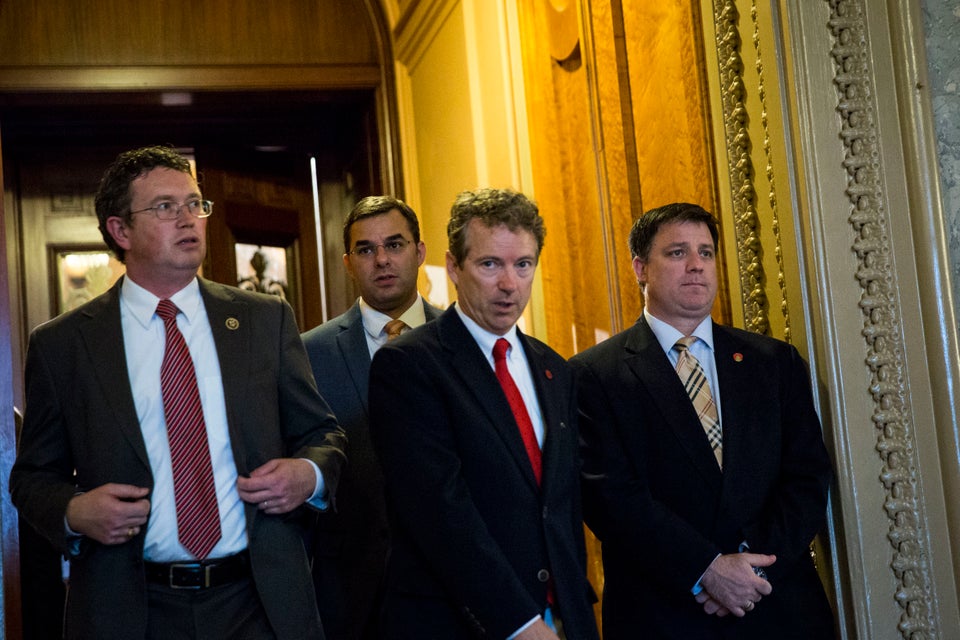
The group of centrist Democratic lawmakers who announced their concerns in May about H.R. 3, House Democrats’ prescription drug affordability bill, featured plenty of the usual suspects, including Rep. Scott Peters (D-Calif.), who received the seventh-most contributions from pharmaceutical industry PACs and led an unsuccessful pressure campaign to stop the Biden administration from supporting a waiver of international patent rules for the COVID-19 vaccine.
But politics watchers were more surprised to see Rep. Jake Auchincloss (D-Mass.), a freshman from a liberal district, as the lead co-author, along with Peters, of the group’s letter to House Speaker Nancy Pelosi (D-Calif.).
The Auchincloss-Peters letter echoed the pharmaceutical industry’s familiar concerns that H.R. 3, a bill that would empower Medicare to negotiate lower prescription drug prices, would discourage research and development. Auchincloss, Peters and eight of their colleagues instead called for a bipartisan bill that would “preserve our invaluable innovation ecosystem.”
Auchincloss has since gotten more specific: His objection is to H.R. 3’s clause capping prescription prices subject to federal negotiation at 120% of the average price in Australia, Canada, France, Germany, Japan, and the United Kingdom, countries where the government takes a much stronger hand in price negotiation.
“Price controls … because of the uncertainty they create, are a massive deterrent to risk capital that invests in the next generation of drugs,” Auchincloss told The Uprising in May, warning that the bill, as currently written, would cost Massachusetts thousands of jobs and delay development of Alzheimer’s and cancer treatments.
Rena Conti, a Boston University business school professor who specializes in prescription drug policy, told HuffPost that prophecies of doom about the impact of price negotiation on innovation are straight from Big Pharma’s playbook for thwarting reform.
“There is very limited daylight, if any, between what his position was in May and Pharma’s positions,” Conti said. “That’s actually quite interesting given that he’s a Democrat from Massachusetts.”
Dr. Aaron Kesselheim, a Harvard Medical School professor who has extensively studied the role that federal government research plays in private-sector pharmaceutical innovation, called the frequent pharmaceutical industry talking point a “scare tactic.”
Even when public officials and advocacy groups repeat the over-the-top warnings earnestly, they have often been unwittingly swayed by Big Pharma’s power to shape the discourse, according to Kesselheim.
Pharmaceutical companies “have such a loud pulpit, such a loud microphone because they invest so much money in lobbying and advertising,” Kesselheim said.
Conti, Kesselheim and other advocates of government price negotiation note that a significant amount of pharmaceutical industry drugs already originate with federal government research ― funding for which H.R. 3 would increase. The development of the Hepatitis C drug sofosbuvir ― sold by Gilead under the brand Sovaldi ― is just one recent example of how federal research incubated drugs later sold for profit in the private sector.
And countries like Germany, where drug maker BioNTech helped develop Pfizer’s COVID-19 vaccine, have innovative climates for development despite stricter price regulations that yield significantly lower costs for patients.
“We can have both affordable drugs and continue to fund research and other activities that bring the next generation of drugs to market.”
- Rena Conti, professor, Boston University School of Business
“We can have both affordable drugs and continue to fund research and other activities that bring the next generation of drugs to market,” said Conti, who opposed government price negotiation until, after years of research, she became convinced that no other mechanism would lower costs. “We already do so.”
Federal campaign finance data provides a potential explanation for Auchincloss’ prominent role in the effort to make H.R. 3 friendlier to prescription drug makers.
During his 2020 run, Auchincloss benefited from the support of a super PAC ― a rarity for a first-time candidate competing for an open seat ― that was funded in significant part by figures with close ties to the pharmaceutical industry.
The single-largest donor to the pro-Auchincloss super PAC, Experienced Leadership Matters, was Dr. Laurie Glimcher, Auchincloss’ mother, who gave $105,000 of the group’s $575,000 haul. Glimcher, president of Boston’s Dana-Farber Cancer Institute, holds a seat on the board of directors of GlaxoSmithKline, a British pharmaceutical giant.
Patrick Ronan, CEO of Greenleaf Health, which consults pharmaceutical companies seeking FDA approval for drugs, contributed $5,000 as well. (Auchincloss’ sister Kalah is an executive vice president at the company.)
Aside from Auchincloss and the super PAC supporting him, Ronan has only ever contributed to Republican candidates and campaign arms. Then-Sens. Kelly Loeffler and David Perdue (R-Ga.), whose losses in January enabled Democrats to take over the Senate, were among the more recent beneficiaries of Ronan’s largesse.
Other donors to the pro-Auchincloss super PAC include health care industry investors like Robert and Jonathan Kraft, who gave the super PAC $5,000 and $5,600, respectively. It is unclear what parts of the health care industry the father-son duo are invested in, though their website specifically mentions “life sciences,” a term for traditional pharmaceutical or biologic development.
In addition, while Auchincloss has pledged to reject contributions from corporate political action committees, he is a major recipient of campaign donations from top executives at pharmaceutical companies.
Auchincloss received $65,435 from pharmaceutical company employees in the 2020 election cycle, according to Open Secrets’ analysis of federal campaign finance data.
“Donations do not impact his views ― his 100% voting record with the Democratic caucus speaks for itself.”
- Matt Corridoni, spokesperson, Rep. Jake Auchincloss (D-Mass.)
That finding in itself is not newsworthy. After all, the political giving habits of a company’s rank-and-file employees need not reflect the views of their employers.
But $59,200 of the $65,435 came from senior executives, according to a HuffPost analysis of federal campaign finance data. His donors during that first election cycle include the CEOs of Alnylam Pharmaceuticals, Amgen, Dicerna Pharmaceuticals, Frequency Therapeutics, Hemera Biosciences, Ironwood Pharmaceuticals, Lytica Therapeutics, Proterris, and Tilos Therapeutics, as well as the chief scientific officers of Cartesian Therapeutics and Vertex Pharmaceuticals.
Many of these companies are located in or around Auchincloss’ district in the Boston area, one of the country’s densest clusters of development for biologics ― medical treatments that use living organisms or other elements that make them more complex than a traditional, chemically synthesized drug.
Thus far this election cycle, pharmaceutical executives have contributed $11,850 to Auchincloss’ re-election campaign.
Neither of those tallies includes pharmaceutical company board members like Glimcher; pharmaceutical regulatory consultants like Ronan and Kalah Auchincloss; financiers specializing in pharmaceutical and life-science investment like BioImpact Capital’s Chris Bardon; executives at trade groups that represent pharmaceutical companies; or spouses of pharmaceutical executives.
When accounting for those donors, Auchincloss’ total haul from pharmaceutical industry insiders swells to $94,800 for the 2020 election cycle, and $39,250 so far this cycle.
Although Auchincloss could not legally coordinate with any groups supporting him independently, he is surely aware of the super PAC’s support for his bid. Auchincloss won the crowded Democratic primary in Massachusetts’ 4th Congressional District by a single percentage point.
Auchincloss spokesperson Matt Corridoni vehemently denied any suggestion that the super PAC’s funders affected Auchincloss’ stance.
“There’s no conflict of interest because the PAC was not started by the Congressman and he is prohibited from coordinating with them,” Corridoni said in a statement. “Any suggestion that he has done so without proof is journalistic malpractice and calls into question the integrity of your outlet.”
“Outside spending is a fact of life in national politics, which is why we need to overturn Citizens United, something Congressman Auchincloss supports,” Corridoni added. “Congressman Auchincloss doesn’t make his decisions based on positive or negative IEs.”
As for the direct campaign donations from pharmaceutical executives and other industry insiders, Corridoni said, “Donations do not impact his views ― his 100% voting record with the Democratic caucus speaks for itself.”

The Former Republican Who Won A Crowded Primary
Campaign contributions are rarely the only factor shaping an elected official’s views or actions. And even Massachusetts politicians who are more progressive than Auchincloss have been vulnerable to the siren song of advocating for regional corporate interests and the jobs with which they are associated. Democratic Sens. Elizabeth Warren and Ed Markey, for example, pushed for repeal of the Affordable Care Act’s excise tax on medical devices.
But there are fewer cases of Bay State Democrats seeking to water down one of Speaker Pelosi’s top priorities.
And Auchincloss, who succeeded former Rep. Joe Kennedy III, faces suspicion from progressives dating back to his contentious primary win in September 2020.
Massachusetts’ 4th, which includes the highly educated Boston suburbs as well as white working-class redoubts like Fall River, is not the most left-wing district in the state.
But it is a solidly Democratic and liberal seat, and Auchincloss is a centrist who was briefly a registered Republican while working to elect Massachusetts Gov. Charlie Baker in 2013 and 2014.
In 2020, Auchincloss benefited from a glut of left-leaning candidates that divided the progressive vote.
Jesse Mermell, a former aide to former Massachusetts Gov. Deval Patrick (D) and the progressive consensus pick, was the narrow second-place finisher after Auchincloss. She had competition in the progressive lane from at least two other contenders: epidemiologist Natalia Linos, who got 11.6% of the vote, and financial regulator Ihssane Leckey, who received 11.1%.
In May, Auchincloss got some pharmaceutical industry praise for his stance against international reference pricing. The AstroTurf group Alliance for Patient Access, which is funded by pharmaceutical companies, sent mailers to voters in the district dubbing him a “champion of patient access.”
But in an effort to remind Auchincloss that he faces pressure from the left, the group Social Security Works paid for a mobile billboard declaring that Auchincloss is “blocking efforts to lower your drug prices.” The billboard, transported across Massachusetts’ 4th on the bed of a truck for a week in late May, provided Auchincloss’ district office phone number and encouraged voters to register their objections.
“Our office does not make decisions based off of D.C. stunts and saying there was ‘blowback’ is wishful thinking on the part of whoever pitched this story.”
- Corridoni
By early June, Auchincloss was publicly committing to vote for H.R. 3 regardless of its final makeup. And on June 25, he became a co-sponsor of the legislation.
Alex Lawson, executive director of Social Security Works, took credit for Auchincloss’ change of tone. “He had to be dragged kicking and screaming to that position, but gobs of pharmaceutical cash no longer outweigh the rage of the American people over our ludicrously high drug prices,” Lawson said.
Corridoni took umbrage at the suggestion that the billboard campaign had an effect on Auchincloss’ decision-making.
“Our office does not make decisions based off of D.C. stunts and saying there was ‘blowback’ is wishful thinking on the part of whoever pitched this story,” Corridoni said. “We have been engaged with thoughtful and meaningful conversation on drug pricing with constituents, patient groups, and the Speaker’s office for months. Congressman Auchincloss has long said Democrats are going to pass a bill and he’ll help get it done.”
Corridoni referred to a statement lauding Auchincloss issued by Patients for Affordable Drugs Now, an advocacy group that often collaborates with Social Security Works.
But the June 30 statement congratulates Auchincloss for becoming a co-sponsor of H.R. 3, not for leading a bloc of Democratic skeptics of the bill.
“We are grateful that Reps. [Lori] Trahan and Auchincloss have made clear they support H.R. 3 and will vote for its passage to lower drug prices for Americans,” David Mitchell, a cancer patient who founded Patients for Affordable Drugs Now, said in a statement.

The Long Fight To Tame Big Pharma
Beyond the views of any one congressman, Auchincloss’ brush with progressive pushback provides a window into the sometimes slippery staying power of pharmaceutical-industry influence on Capitol Hill.
For decades, the pharmaceutical industry has used fear-mongering to protect its lucrative patents and intellectual-property rules, quashing political appetite for greater government regulation, even as prices rise astronomically ― in tandem with executive pay.
The warnings are always the same: That the public will not have life-saving medications if the government uses its buying power to negotiate lower prices ― and reduce drug makers’ profit margins.
In 2003, the last time the federal government really had the pharmaceutical industry in its crosshairs, Marjorie Powell, a top official with PhRMA, the pharmaceutical industry’s umbrella lobbying group, said, “When government imposes price controls on an industry, innovation dries up.”
At that time, the industry’s money-soaked lobbying blitz ensured that when then-President George W. Bush and Congress expanded Medicare to cover prescription drugs, the law forbade Medicare from the right to negotiate drug prices with pharmaceutical companies directly ― a clause that then-Sen. John McCain (R-Ariz.) called “outrageous.”
Instead, the bill left the job of haggling to a disparate network of private insurers and middlemen who have proven far less effective at taming prices than a single entity.
“Medicare either negotiates or sets the price for every service it provides except for drugs. It’s the one exception.”
- Dr. Aaron Kesselheim, Harvard Medical School
For example, the Department of Veterans Affairs’ health care system has the power to negotiate prices. As a result, the prices the VA pays are about half as high, on average, as the prices Medicare pays for the same drugs.
The provision prohibiting Medicare price negotiation also carves out an exception that does not apply to any other good or service that Medicare purchases. Medicare is able to negotiate ― or even set ― prices for hospital procedures, doctors’ services, and non-pharmaceutical medical devices, noted Kesselheim, who is the director of Harvard Medical School’s program on regulation, therapeutics and law.
“Medicare either negotiates or sets the price for every service it provides except for drugs. It’s the one exception,” he said. “It’s not only abnormal in the U.S., it’s also abnormal for every other industrialized country in the world, which negotiates the prices of drugs.”
The passage of the Affordable Care Act in March 2010 did not remedy the situation. PhRMA agreed to help finance the bill’s expansion of insurance coverage in exchange for assurances that the federal government would not use the bill as a vehicle for price negotiation or other reforms.
When Democrats re-took the House of Representatives in 2018 though, they made passing a prescription drug bill reversing the 2003 provision a priority.
H.R. 3, the legislation they devised, would empower the Department of Health and Human Services to negotiate prices for Medicare’s prescription drug plans using 120% of the international average as a ceiling for prices. In the event of an impasse in negotiations, the federal government would tax pharmaceutical companies’ profits 100% for every dollar the price exceeds the international reference point. The effect of the bargaining power would be felt throughout the economy as well, since private insurers would be free to use those prices too.

‘An Already Overly Narrow Mini-Negotiation Bill’
At the same time, an initial draft of the bill in 2019 set a minimum of 25 prescription drugs subject to the new negotiation parameters ― effectively only guaranteeing that prices for a fraction of expensive drugs would drop. The Congressional Progressive Caucus threatened to muster the votes to tank the party-line bill, prompting Speaker Pelosi to raise the minimum of negotiable drugs up to 50. The prices of those drugs not subject to negotiation would be permitted to grow only as fast as regular consumer price inflation.
Still, many progressives see the bill in its existing form as a major compromise, making proposals to further dilute it especially objectionable.
“Consumers need comprehensive action to lower prescription drug prices and rein in Big Pharma’s monopoly power, not continued attempts to weaken an already overly narrow mini-negotiation bill,” Rep. Lloyd Doggett (D-Texas), chairman of the House Ways and Means Committee’s health subcommittee, said in a statement.
The bill would reduce federal government spending by $456 billion over a 10-year period and generate $45 billion in new revenue, the nonpartisan Congressional Budget Office projected.
CBO also predicted that by cutting into drug makers’ profits, the legislation would put a modest dent in the quantity of drugs that the pharmaceutical industry develops. Over the first decade of the law’s implementation, companies would develop eight fewer drugs than they otherwise would, according to the CBO.
Affordable drug advocates argue that even that figure overstates the potential negative impact of price negotiation, because of the lack of consistent social value in the types of drugs that the pharmaceutical industry considers profitable to develop. The World Health Organization has warned, for example, that drug makers are not developing enough new antibiotics to combat the growing number of antibiotic-resistant infections.
What’s more, the pharmaceutical industry often devotes resources to copycat, or “me-too,” drugs that make cosmetic changes to existing remedies in order to lock in the lucrative profits afforded by a new patent. Two especially notorious examples are the acid reflux drug Nexium and the cholesterol drug Crestor, which data suggest do not provide significantly different results than much cheaper drugs with the same core makeup.
“In the current system, where we allow drug companies to charge whatever they want for their products, that incentivizes companies to invest in the ways that they can make money the easiest,” Kesselheim said. “That usually involves tweaks to currently available molecules, new formulations of existing products” and other copycat techniques that are not truly clinically valuable.
By creating more socially oriented incentives to guide innovation, H.R. 3 will actually “improve” innovation, Kesselheim argued. A study co-authored by Kesselheim that measured the impact of a similar bill that Germany passed in 2011 found that 98% of drugs that added positive value remained on the market after the law’s passage, while 25% of drugs without added positive value left the market.
“The goal of H.R. 3 is not to just randomly lower prices, but to ensure that we negotiate prices so that prices are more aligned with the clinical benefits of the drug, in which case we will give better pricing signals to drugs that are more meaningful, and less good pricing signals to drugs that are not more meaningful,” he added.
“International reference pricing would not rein in rent-seeking by bad actors in Big Pharma.”
- Corridoni
Some progressives are actually skeptical of international reference pricing on the grounds that it doesn’t go far enough, arguing that even European countries overpay for drugs.
Advocates and allied lawmakers settled on it as a benchmark, because unlike, say, arbitration, international reference pricing is concrete and not vulnerable to industry strong-arming. “It may be higher than necessary, but it’s an absolutely quantifiable number,” said Cathy Hurwit, a former Capitol Hill aide who now advises progressive groups working to lower drug prices. “It’s not subjective.” Kesselheim had a similar assessment. “If it turns out in practice to be a problem, it’s something that can be altered later” as other countries have done, he said.
But Auchincloss maintains that international reference pricing will hamstring innovation and have the effect of importing the flaws of the European system, such as its slow COVID-19 vaccine rollout and distribution process. He insists that he is simply fighting for a “more progressive” prescription drug bill ― one that will reduce prices, but won’t jeopardize treatments for Alzheimer’s disease and other ailments where private-sector innovation has shown promise, but required dozens of unprofitable clinical trials.
“International reference pricing would not rein in rent-seeking by bad actors in Big Pharma,” Corridoni said. “It would severely impair drug development, especially for Alzheimer’s disease, cancer, and other complex medical conditions. And it would let the payers off the hook for their role in rising out-of-pocket costs for patients.”
“The federal government is a key funder for basic research, but it can’t fill the pipeline for the translational research that is crucial to bringing medicines to patients,” Corridoni added.
To back up those claims, Corridoni referred HuffPost to two analyses. The first study, conducted by the Vital Transformation consultancy with funding from PhRMA and other industry groups, concluded that the bill would reduce the number of market-ready products made by “emerging biotech companies” from 64 to eight.
The second study is a simulation conducted by the University of Texas Southwestern Medical Center that was sponsored by, among other groups, RA Capital Management, a pharmaceutical-focused investment firm. Peter Kolchinsky, RA Capital’s founding partner and a donor to Auchincloss’ reelection, was one of several judges who assessed investment pitches from teams of graduate students operating under the constraints of H.R. 3. He rejected a hypothetical lung cancer treatment on the grounds that promises of the drugs’ efficacy were exaggerated.
“Bottom line, price controls killed the investment in R&D that is actually possible and forced teams to resort to making promises that they couldn’t keep,” Kolchinsky said.

